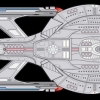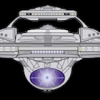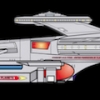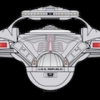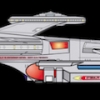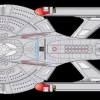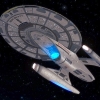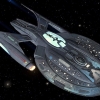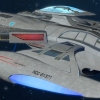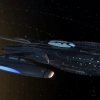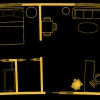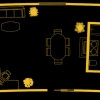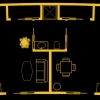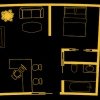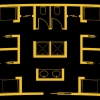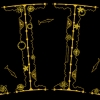Sidebar
This is an old revision of the document!
Vessel
Summary
The USS Republic (NCC-81371) is a Luna-class starship, and the sixth Federation vessel to bear the name. The Luna-class model was first commissioned with the launching of the USS Titan (NCC-80102), and while ships of the class are normally named for moons in the Sol system, the Republic was special in that she was the first Luna-class ship constructed following the Remnant Attacks of stardate 58851 in which the former Galaxy-class USS Republic (NCC-76241) played no small role in resolving.
The Luna-class Republic is a 17-deck long-range light exploration cruiser containing a large compliment of laboratories and research facilities that host some of the Federation's most advanced scientific sensory equipment available. It's substantial cargo capacity allows it to operate far beyond the range of most exploration vessels, and while limited in its capacity to accommodate civilians, onboard amenities permit crew to host family members during extended missions away from port. As part of the Federation president's initiative to diversify the crew of a select number of Starfleet vessels, Republic has been outfitted with the capacity to billet a small number of non-humanoid aquatic crew. Approximately 15% of the ship is configured with water tunnels and underwater workstations, as well as hosting a half-dozen Class-O cetacean suites, each capable of providing an oceanic living space and work environment for crew with delphinoid or mysticetid heritage and their ilk.
In a first for exploration-class vessels, the ship designers took a lesson from the plight of the USS Voyager (NCC-74656), and have equipped Republic with a class four industrial (CFI) replicator: a holodeck-sized matter-replication system that vertically spans two decks, and is capable of producing large, intricate constructs such as vehicles and small buildings as well as engineering spares and high-volume consumable supplies in bulk. This sophisticated fabrication facility requires large amounts of power to operate at full capacity, necessitating its location on the engineering deck just above the warp core's main EPS power junction, and directly adjacent to both the shuttle deck and the cargo transporter complex for expedited transfer and offloading of replicated material. The CFI replicator has been incorporated into Republic to serve not only for contingency colony resupply and disaster relief missions, but also as a vital survival tool should the ship ever be stranded in remote areas of the galaxy where communications and supply lines back to Federation space are non-existent. Given enough time and allocated power, the CFI replicator makes it possible for Republic to establish a small self-sufficient colony with modern Federation facilities, complete with space-based infrastructure such as satellites and warp-capable shuttlecraft.
The ship has three detachable sections: The mission pod, the saucer section, and the engineering section. While separation of any one of these sections would only occur during extreme emergencies, the mission pod is a mission-specific module that is replaceable at any standard Starfleet drydock, and can be detached with minimal effects to overall ship operations, affecting only long-range sensors and partially inhibit ship-to-ship weaponry. In contrast, separating the saucer from the engineering section should only be done for the most catastrophic circumstances, as the two operate best while conjoined together, and reintegration is a time-consuming process that requires a complex maintenance operation. This drawback in re-mating the two sections was deemed an acceptable trade-off for a robust, expedited separation mechanism, which allows the two sections to detach with such speed and force that they can reach a distance of over 100 kilometers apart in less than 10 seconds after given the command to separate. The contingency was considered a life-saving backup in the event of an inoperable warp-core ejection system during an overload event or impending core breach. Should this contingency ever be used, the saucer section is fully capable of shielded atmospheric re-entry with controlled soft-landing on any planetary body as long as impulse engineering and associated power systems remain intact.
Bridge Plaque
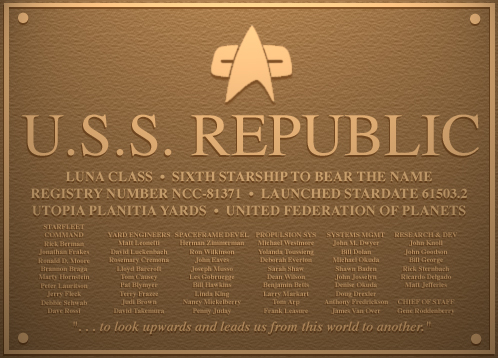
Schematics & Visuals
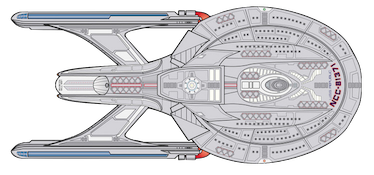 | 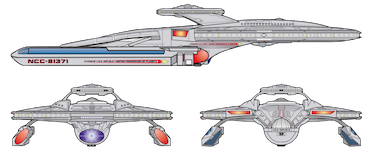 |
||
| Luna Class Starship USS Republic (NCC-81371)1) | |||
Specifications
Class / Type Dimensions Strength Indices Armament Defense Speed Transporters Refit Cycle Diplomacy Accommodations
| Class Name: | Luna Class |
| Type: | Light Explorer |
| Information Source: | Daystrom Institute Technical Library extract (appended) |
| Length: | 450 meters |
| Beam: | 200 meters |
| Height: | 80 meters |
| Mass: | 1,400,000 metric tons |
| Cargo Capacity: | 60,000 metric tons |
| Decks: | 17 |
| Crew: | 350 |
| Evacuation Limit: | 1000 |
| Beam Weapons: | 5 x Type VIII phaser arrays, total output 5,000 TeraWatts |
| Missile Weapons: | 3 x Pulse fire quantum torpedo tubes with 50 rounds each |
| Shields: | Standard shield system, total capacity 900,000 TeraJoules |
| Hull: | Standard Duranium / Tritanium Single hull |
| Structure: | Standard level Structural Integrity Field |
| Standard 6-person: | 4 |
| Emergency 22-person: | 2 |
| Cargo Transporters: | 3 |
| Class 4 Industrial Replicator: | 1 |
| Diplomatic Level: | 2 | Diplomatic courier function only. Diplomats housed in crew quarters for short duration interstellar missions. |
| Briefing rooms: | 3 | 40 square meters, 10 seats each |
| VIP Dining Facilities: | 1 | Officer's mess with attached specialty kitchen (separate from regular crew mess hall) |
| 15% of all facilities, including interconnecting corridors, capable of supporting Class H, K, L, or O environments, limited to decks 4 through 14 | ||
| Senior officers quarters: | 10 | Republic's senior officer's are 60 square meters in size, and separated into a living area hosting a sofa, a work desk, and a food replicator, along with a spacious sleeping chamber with a large bed, private lavatory, and walk-in closet. There are only 10 senior officer's quarters aboard ship, all located solely in the saucer section on deck 5, and situated along the outer rim bulkheads thus permitting viewports to the outside of the vessel. These style quarters are reserved only for the ship's senior staff with rank of lieutenant commander and above. Due to the lack of guest quarters, ambassadors and VIPs are generally housed in one of the senior officer's quarters when Republic is acting as diplomatic courier, requiring the permanently-assigned officer to vacate the room temporarily while the guests are aboard. |
| Private family suites: | 15 | The largest and most spacious of crew quarters aboard Republic are the private family suites, taking up 120 square meters of deck space each. Consisting of three separate sleeping chambers (one main and two smaller), the main bedroom each has an adjoined private lavatory, and another shared lavatory is situated near the two remaining bedrooms. The main living room chamber provides ample habitation space, complete with a sofa, work desk, food replicator, and family dining table. Private family suites are few in number aboard Republic, and thus, are a premium commodity among the crew as they are assigned at the captain's discretion, and based purely on rank and seniority aboard ship. The family suites are one of only two styles of crew quarters located on the outer rim of the ship, allowing them to have expansive viewports along the exterior bulkhead. All private family suites are located in the saucer section only. |
| Junior officer suites: | 35 | Junior officer suites are generally assigned to crew with the rank of ensign, lieutenant junior grade, and lieutenant, and who are each free of any department head duties. These 70 square meter double-suites share a single lavatory facility, but have separate living/sleeping quarters with a large work desk, walk-in closet, as well as their own entrance door to the outside corridor. This is at the expense of other amenities such as food replicators, as junior officers are expected to socialize themselves with the rest of the ship's crew and eat in the messhall, or in the officer's mess for formal functions. Like the senior officer quarters, all junior officer quarters are found in the saucer section only. |
| Senior enlisted quarters: | 30 | Senior enlisted quarters have similar amenities as the senior officer's quarters, but within a reduced volumetric footprint of only 40 square meters. They possess a smaller sleeping chamber and living area, private lavatory facilities, as well as a food replicator and an expanded work desk since senior enlisted often do not have a separate duty office elsewhere on the ship. Senior enlisted quarters are normally assigned to crew who possess the rank of petty officer second class and petty officer first class, as well as the handful of chief petty officers and senior chief petty officers assigned aboard. Luna-class vessels are generally too small to have a master chief petty officer assigned permanently to the crew, but if one was, they would report directly to the captain and first officer, and be assigned senior officer's quarters. Officers with the rank of lieutenant or below can also be assigned senior enlisted quarters instead of sharing a junior officer suite, but only for those who serve as departments heads. Most of the senior enlisted quarters are located in the saucer section, and only about a dozen are located in the engineering section. |
| Junior enlisted bunkrooms: | 50 | In contrast to higher ranking crew quarters, junior enlisted bunkrooms are fairly austere, totaling an area of 50 square meters. These single-room dormitories consist of four double-bunk sleeping alcoves situated around twin lavatory facilities in an open floor plan. There are individual walk-in storage closets near each alcove, plus a pair of ultrasonic hanging uniform de-soilers, but newly replicated clothing is provided by the ship's quartermaster, as there are no replicators, nor any other leisure appliances in the bunkroom, relegating the room strictly to sleeping and personal hygiene. Due to this, it is expected that junior enlisted avail themselves of the ship's many recreational amenities during their off-duty hours, and take their meals in either the messhall or one of the many snack bars/reading lounges located regularly throughout the ship. Under normal operations, four junior enlisted crew are assigned to a bunkroom, and each may utilize one of the four double-bunk alcoves as they see fit, choosing either the top or bottom bunk to sleep in while leaving the other empty. During high-capacity operations, a bunkroom can accommodate eight permanently-assigned junior enlisted crew, or double that under contingency “hot-bunking” conditions where different crew continually occupy each bunk on rotating shifts throughout a 24-hour day. Junior enlisted bunkrooms are generally assigned to crew with the rank of crewman, crewman first class, and petty officer third class, and about half are located in the saucer section, while the rest are in the engineering section. |
| Class-O Cetacean suites: | 6 | Due to Republic's unique mission profile that requires it to host up to 15% non-humanoid crew, the vessel has been outfitted with six 200-square meter underwater living facilities for aquatic crew members. Composed of two sets of three combined rooms that span two decks vertically, these chambers can house up to two delphinoid-sized crew each, and can also be reconfigured into a pair of larger 600-square meter tanks to accommodate up to two mysticetid-sized passengers of 30 tons or less. The high-capacity water filtration system continually recycles and re-oxygenates the liquid water environment, maintaining temperature and salinity to within the most comfortable range for the species assigned to the chamber. Installation of the cetacean suites on Republic sacrificed the space originally intended for a pair of two-story holodecks normally found on other Luna-class vessels. Therefore, holographic entertainment must be relegated to the smaller, single-deck holosuites on deck 6, necessitating the crew to be judicious with their off-duty recreation schedules. |
Deck Profile
Auxillary Vessels
Captain's Skiff Type-9 Shuttles Type-11 Shuttles Type-18 Shuttlepods Workbees Escape Pods Cetacean Lifeboats

